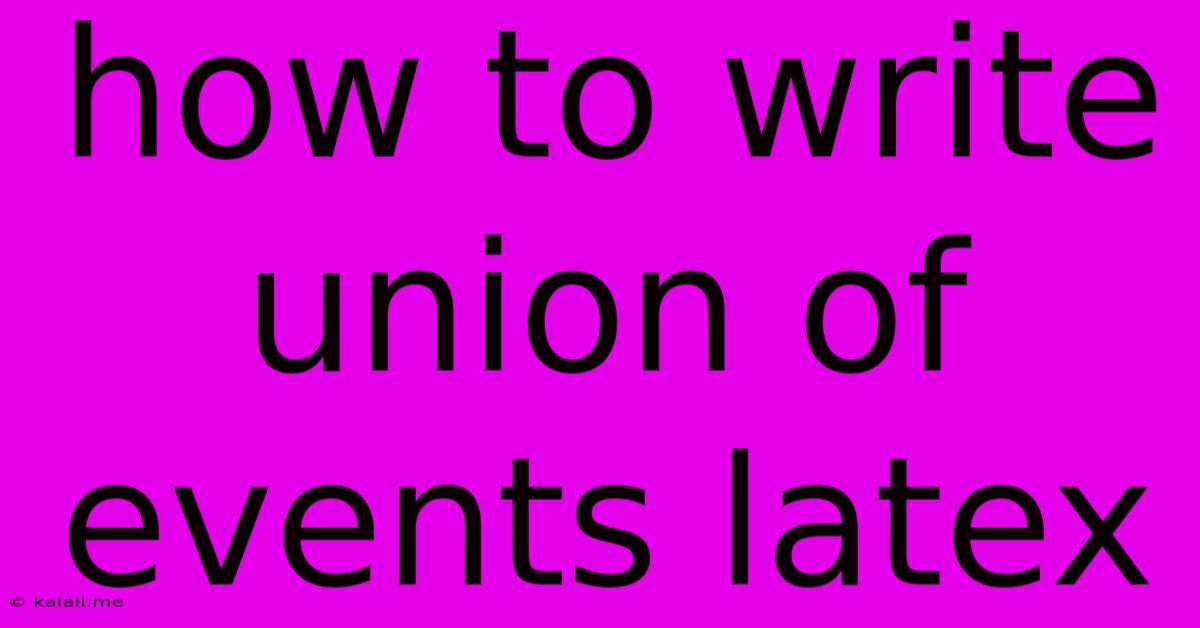How To Write Union Of Events Latex
Kalali
May 25, 2025 · 3 min read

Table of Contents
How to Write the Union of Events in LaTeX: A Comprehensive Guide
This article provides a comprehensive guide on how to typeset the union of events using LaTeX, catering to both beginners and experienced users. We'll cover various scenarios, including different notations and stylistic choices, ensuring your mathematical expressions are clear, concise, and visually appealing. This guide will equip you with the knowledge to flawlessly represent union operations within your LaTeX documents, whether you're working on a simple assignment or a complex research paper.
The union of events, denoted by ∪, represents the combination of all outcomes in multiple events. Understanding how to correctly represent this in LaTeX is crucial for conveying your mathematical ideas accurately. We'll explore the most common methods, including the use of standard symbols and more sophisticated techniques for complex scenarios.
Basic Union Notation in LaTeX
The simplest way to represent the union of two events, A and B, is using the \cup command:
A \cup B
This will render as A ∪ B. This is perfectly acceptable for most situations. For the union of multiple events, simply extend this notation:
A \cup B \cup C
This will render as A ∪ B ∪ C. LaTeX handles spacing automatically, ensuring the symbols are correctly positioned and visually pleasing.
Using \bigcup for Unions of Multiple Sets
When dealing with a larger number of sets or an infinite number of sets, \bigcup provides a more compact and elegant representation:
\bigcup_{i=1}^{n} A_i
This will render as a large union symbol with a subscript indicating the range of the index. This is particularly useful when expressing the union of a sequence of sets. You can replace n with \infty for an infinite union:
\bigcup_{i=1}^{\infty} A_i
Styling Your Union Symbols: Size and Placement
For improved visual clarity, especially in complex equations, you can adjust the size of the union symbol. The \displaystyle command is particularly helpful for ensuring that the symbol is appropriately sized within larger equations:
\displaystyle \bigcup_{i=1}^{n} A_i
This will render a larger union symbol, improving readability within complex mathematical expressions.
Incorporating Union Notation Within Larger Expressions
The union symbol integrates seamlessly within larger mathematical expressions. For example, you can use it within probability calculations:
P(A \cup B) = P(A) + P(B) - P(A \cap B)
This shows how the union symbol interacts naturally with other mathematical operators. Remember to use appropriate spacing and parentheses to maintain clarity.
Advanced Techniques and Considerations
For highly specialized situations or stylistic preferences, you might explore additional packages that offer alternative union symbols or customization options. However, for most standard mathematical notation, the techniques outlined above are sufficient and recommended. Maintain consistency in your notation throughout your document for the sake of clarity and professionalism.
Conclusion
Mastering the use of union notation in LaTeX is essential for any student or researcher working with set theory and probability. By using the commands and techniques described in this guide, you can ensure that your mathematical expressions are not only correct but also visually appealing and easy to understand. Remember to always prioritize clarity and consistency in your notation to enhance the overall readability of your work.
Latest Posts
Latest Posts
-
Weight Of 1 Liter Of Water
May 25, 2025
-
What To Use Instead Of Parchment Paper
May 25, 2025
-
How Do You Get An Umbreon On Pokemon Go
May 25, 2025
-
How To Stop Sneakers From Squeaking
May 25, 2025
-
Black Decker Lht 2436 Hedge Trimmer Smokes And Stops
May 25, 2025
Related Post
Thank you for visiting our website which covers about How To Write Union Of Events Latex . We hope the information provided has been useful to you. Feel free to contact us if you have any questions or need further assistance. See you next time and don't miss to bookmark.